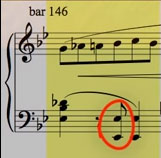Welcome to Part 2 in our series on the Chopin G minor Ballade. In Part 1 we discussed how the middle section of this piece requires you to switch your techniques rapidly. We are going to cover the next section which doesn’t get any easier. I’ll provide some tips on how to approach this section and practice techniques that will help you master it.
Let’s discuss this first section:

With the right hand, you have a very quick passage that requires a lot of finger work. As I’ve recommended in the past lesson, try taking the passage slowly and working your way up to speed. Start at a comfortable speed and practice with the metronome. Once you have the section down without any issues turn the metronome speed up one notch and start again. Repeat this process until you have the section up to speed. Make sure that you delineate all notes clearly.
Let’s focus now on the left-hand, which has this particular rhythm:

It’s very snappy and precise and you want to bring out the rhythm of this particular section against the fast passage in the right hand. As always I recommend slow practice but in this particular section, I recommend exaggerating the rhythm. Instead of playing the eighth notes as written, play them as sixteenth notes.

So right here, for example, you can wait an extra sixteenth rest and play the following note as a sixteenth note instead of an eighth note as written. Now why would you want to play the rhythm wrong and not as written? Well, this is only for your slow practice. When the piece gets up to full speed sometimes the eighth notes can sound limp and you want to accentuate the snappy rhythm of these notes. The best way to do this is to wait and play these as sixteenth notes instead of in your slow practice. Once you get this section up to speed, you will be prepared to play these notes quickly enough; you will notice the difference in your playing.
Let’s go on to the next section in this piece:

This section is best practiced by playing two-note groups together in the right hand. Once you start to get comfortable in your slow practice you can break up these chords and play the notes as written. Why should you practice this section in chords? Because you can train your fingers to be in the right position before you have to play the notes. Doing this will greatly benefit your finger positions and allow you to be much more comfortable when playing up to tempo.
I hope this has been helpful to you, there will be more tips coming soon. As always if you have any questions please feel free to email or call us directly: Info@LivingPianos.com (949) 244-3729.


